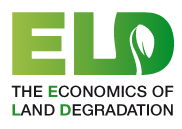The Economics of Land Degradation (ELD) Initiative has published the results of a global study titled ‘Does Land Degradation Increase Poverty in Developing Countries?' The study describes the distribution of rural populations on degrading agricultural land as an “overwhelmingly developing country problem,” and concludes that the associated spatial distributions of rural populations could impact significantly on future poverty reduction efforts.
 23 May 2016: The Economics of Land Degradation (ELD) Initiative has published the results of a global study, titled ‘Does Land Degradation Increase Poverty in Developing Countries?’ The study describes the distribution of rural populations on degrading agricultural land as an “overwhelmingly developing country problem,” and concludes that the associated spatial distributions of rural populations could impact significantly on future poverty reduction efforts.
23 May 2016: The Economics of Land Degradation (ELD) Initiative has published the results of a global study, titled ‘Does Land Degradation Increase Poverty in Developing Countries?’ The study describes the distribution of rural populations on degrading agricultural land as an “overwhelmingly developing country problem,” and concludes that the associated spatial distributions of rural populations could impact significantly on future poverty reduction efforts.
The objectives of the study, which was funded by the Deutsche Gesellschaft für Internationale Zusammernabeit (GIZ), Germany, and covered 83 developing countries, was to examine whether the various spatial distributions of rural populations on degrading and improving agricultural land in 2000 affected changes in the rate of poverty between 2000 and 2012 in these countries.
The study team developed a global data set to enable the tracking of progress to combat degradation over a five-year period (2000-2015), and conducted an analysis of the links between poverty and the share of rural populations on degrading versus improving agricultural land. Based on these parameters, the researchers estimated that 1.33 billion people worldwide were located on degrading agricultural land (DAL) in 2000, of which 1.26 billion were in developing countries. They also found 1.54 billion rural people to be living on improving agricultural land (IAL), with 1.34 billion in developing countries. The study further estimated that at current trends, populations on DAL would increase by between one and 2.9 million hectares annually between 2000 and 2030, which, coupled with the rising rural populations in many developing countries, would not only undermine poverty reduction efforts, but exacerbate the vulnerability of the poor and their economic livelihoods to climate change.
The study found that persistent land degradation reduces the productivity of agricultural systems, on which many rural poor depend, thus trapping them in subsistence-level poverty. By disaggregating rural populations in “remote DAL” using market access data – with remote populations characterized by five or more hours of travel to a city with a population of more than 50,000 – the researchers concluded that this “critical population group” appears to be expanding by over 1% annually across the developing world, with the highest growth being in sub-Saharan Africa, at 4%. The study thus concludes that the income-generating benefits of economic growth may bypass poor households coping with land degradation, especially in remote locations with limited market access.
The study was supplemented by case studies in Chile, China, Ethiopia, Indonesia, Mexico, Rwanda and Uganda, which estimated declines in overall agricultural productivity due to land degradation of around 3–7% per year, an order of magnitude larger than the estimated cost of remediation.
Based on the main findings, the study team emphasized the need to raise the numbers of rural people on IAL, especially in the remote regions of developing countries, by introducing rural development strategies that: invest in the enhancement of the livelihoods of agricultural households and market access; improve agricultural land wherever possible; and, if necessary, encourage out-migration of households “on the DAL that is beyond improvement.” [ELD Announcement] [Publication: Does Land Degradation Increase Poverty in Developing Countries?] [IISD RS stories on economics of land degradation]